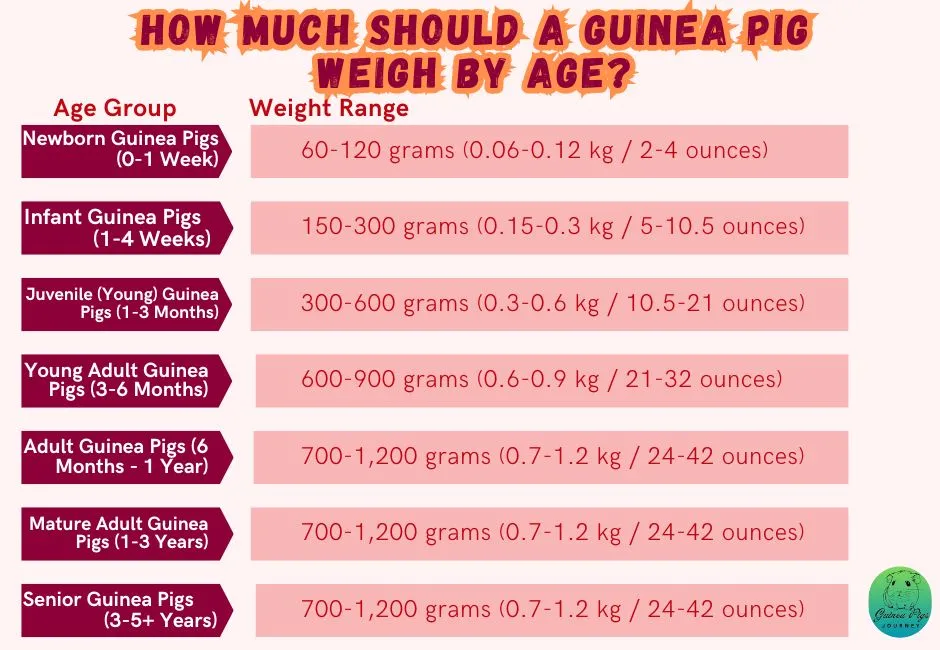Guinea pigs, also known as cavies, are popular pets and lovely creatures due to their friendly nature and relatively easy care requirements. However, maintaining their health does not only involve regular monitoring of their height, size, proper diet plan, etc. but also a responsible guinea pig parent should also monitor how much should a guinea pig weigh according to their sex, age, and breed and also their diet and care. It is not easy to know the exact weight of guinea pigs with different breeds as some are just naturally bigger than others, while others, just like Peruvian guinea pigs are full of hair that can make them look fat and bigger.
Knowing how much should a guinea pig weigh in pounds, kilograms, or grams is crucial to ensuring they are healthy and fit. So, let’s explore the ideal weight range for guinea pigs, the factors influencing their weight, and tips for maintaining their optimal health.
What Is A Healthy Guinea Pig Weight?
A gram scale is the best and most appropriate way to monitor your guinea pig’s weight. It is crucial to weigh in weekly to ensure that your guinea pig maintains a healthy body weight. One of the best ways to check your guinea pigs’ weight is to observe them regularly such as walking differently, battling to walk, and their daily activities and decrease in them is a sign to keep a reference and observe a problem to rectify it.

How Much Should a Guinea Pig Weigh in kg?
Average Adult guinea pigs typically weigh between 0.7 and 1.2 kilograms, the specific weight can vary depending on factors such as breed, gender, and overall health.
How Much Should a Guinea Pig Weigh in Gram?
Average Adult guinea pigs typically weigh between 700 and 1200 grams.
How Much Should a Guinea Pig Weigh in Pounds and Ounces?
According to the imperial measurements in some parts of the world, adult guinea pigs usually weigh between 1.5 and 2.6 pounds. This range translates to approximately 24 to 42 ounces.
What Is The Differences Between Male and Female Guinea Pig Weight?
Male guinea pigs (boars) are generally larger and heavier than female guinea pigs (sows). Boars usually weigh between 900 and 1,200 grams, which is about 2 to 2.6 pounds or 32 to 42 ounces. while sows (female guinea pigs) typically range from 700 to 900 grams, equating to approximately 1.5 to 2 pounds or 24 to 32 ounces.

When To Worry About Guinea Pigs Weight?
It is recommended to monitor and observe the weight of your guinea pigs weekly by using one of the best tools available or with your best judgment so that your guinea pigs can maintain a healthy life. If you notice any sudden weight gain or weight loss, may often be a sign of an underlying health problem such as obesity, pregnancy, malnutrition, scurvy, bloating, etc. A good rule of thumb about acceptable weight gain for an adult guinea pig and when it’s time to worry is:

- A sudden increase in weight of around 25g or 1 ounce: a small amount of weight gain or fluctuation is normal and nothing to be too concerned about.
- A sudden Increase in weight of 55g or 2 ounces: Although there is still no cause for serious alarm. However, you need to be alert and careful, this kind of weight gain suggests changes need to be made to your guinea pig’s diet sooner rather than later.
- A sudden increase in weight of 85-100g or 3-4 ounces: This kind of weight gain is an extreme alert and cause for alarm, and you need to get your guinea pig to the vet for a medical check-up.
How Much Should a Guinea Pig Weigh By Age?
Guinea pigs have distinct growth stages from birth to adulthood and mature age. Monitoring their weight throughout these stages is crucial for ensuring their healthy development of body parts as well as living a healthy and long span of life.

| Age Group | Weight Range | Description |
| Newborn Guinea Pigs (0-1 Week) | 60-120 grams (0.06-0.12 kg / 2-4 ounces) | At birth, guinea pigs are born fully furred, with open eyes, and can eat solid food within a few hours. However, they are primarily nursed by their mother during this stage. |
| Infant Guinea Pigs (1-4 Weeks) | 150-300 grams (0.15-0.3 kg / 5-10.5 ounces) | During the first month, guinea pigs grow rapidly. They start exploring solid foods more actively while still nursing. By the end of this period, they are usually weaned from nursing by mothers. |
| Juvenile (Young) Guinea Pigs (1-3 Months) | 300-600 grams (0.3-0.6 kg / 10.5-21 ounces) | Juvenile guinea pigs continue to grow quickly. They become more active and playful, requiring a balanced diet rich in hay, fresh vegetables and fruits in moderation, and a small number of pellets. |
| Young Adult Guinea Pigs (3-6 Months) | 600-900 grams (0.6-0.9 kg / 21-32 ounces) | Growth begins to slow down, but young adults still gain weight steadily. At this stage, they reach sexual maturity and their adult characteristics become more prominent. |
| Adult Guinea Pigs (6 Months – 1 Year) | 700-1,200 grams (0.7-1.2 kg / 24-42 ounces) | By six months, most guinea pigs reach their full adult weight. They maintain this weight with a stable diet and regular exercise. Males are typically heavier than females. |
| Mature Adult Guinea Pigs (1-3 Years) | 700-1,200 grams (0.7-1.2 kg / 24-42 ounces) | Mature adults maintain a steady weight. Regular health check-ups and a balanced diet are crucial to prevent obesity and other health issues. |
| Senior Guinea Pigs (3-5+ Years) | 700-1,200 grams (0.7-1.2 kg / 24-42 ounces) | Senior guinea pigs may experience slight weight changes due to aging. They might become less active, so monitoring their diet and health becomes increasingly important. |
How Much Should a Guinea Pig Weigh By Breeds?
Guinea pigs come in various breeds, each with distinct characteristics, including their average weight. Understanding the average weight and specific care requirements of different guinea pig breeds can help you ensure your pet stays healthy and happy.

| Breeds of Guinea Pigs | Average Weight |
| American Guinea Pig | 0.7-1.2 kg (700-1200 grams / 1.5-2.6 pounds) |
| Abyssinian Guinea Pig | 0.8-1.2 kg (800-1200 grams / 1.7-2.6 pounds) |
| Peruvian Guinea Pig | 0.7-1.2 kg (700-1200 grams / 1.5-2.6 pounds) |
| Silkie (Sheltie) Guinea Pig | 0.8-1.2 kg (800-1200 grams / 1.7-2.6 pounds) |
| Teddy Guinea Pig | 0.7-1.2 kg (700-1200 grams / 1.5-2.6 pounds) |
| Texel Guinea Pig | 0.7-1.2 kg (700-1200 grams / 1.5-2.6 pounds) |
| Skinny Pig | 0.8-1.1 kg (800-1100 grams / 1.7-2.4 pounds) |
| Baldwin Guinea Pig | 0.7-1.2 kg (700-1200 grams / 1.5-2.6 pounds) |
| Rex Guinea Pig | 0.8-1.4 kg (800-1400 grams / 1.7-3.1 pounds) |
| Coronet Guinea Pig | 0.7-1.2 kg (700-1200 grams / 1.5-2.6 pounds) |
| Crested Guinea Pig | 0.7-1.2 kg (700-1200 grams / 1.5-2.6 pounds) |
| Himalayan Guinea Pig | 0.7-1.1 kg (700-1100 grams / 1.5-2.4 pounds) |
| Merino Guinea Pig | 0.7-1.2 kg (700-1200 grams / 1.5-2.6 pounds) |
| Lunkarya Guinea Pig | 0.8-1.3 kg (800-1300 grams / 1.7-2.9 pounds) |
| Swiss Guinea Pig | 0.8-1.2 kg (800-1200 grams / 1.7-2.6 pounds) |
| Ridgeback Guinea Pig | 0.7-1.1 kg (700-1100 grams / 1.5-2.4 pounds) |
| Sheba Mini Yak | 0.8-1.2 kg (800-1200 grams / 1.7-2.6 pounds) |
What Are The Signs Of Healthy And Unhealthy Weight In Guinea Pigs?

Underweight Guinea Pig: If you weigh your guinea pig and you find the weight of your guinea pig more than 20% below ideal or average body weight that is a sign of an underweight guinea pig. In that case, your guinea pigs’ ribs, spine, or hip bones are prominent and extremely visible and can be easily felt with a slight touch.
Thin Guinea Pig: If the weight of your guinea pig is between 10-20% below ideal or average body weight, each rib is easily felt but not prominent. Hips and spine are easily felt with no pressure and less of an abdominal curve can be seen is a sign of a thin guinea pig.
Ideal Weight Guinea Pig: If you weigh your guinea pig and find out matching with the average weight of your guinea pigs keeping in mind the breed, sex, and age factor then this is the ideal weight of your guinea pig. In ideal weight, ribs are not prominent and cannot be felt individually. Hips and spine are not visible but can be felt. No abdominal curve is seen.
Overweight Guinea Pig: If the weight of your guinea pig is 10-15% above ideal body weight, ribs are harder to feel and recognize. Hips and spine are difficult to feel. Difficulty in moving is a sign of an overweight guinea pig.
Sign of Obesity in Guinea Pig: If the weight of your guinea pig is 15-20% above ideal body weight with a bulging belly, visible fat deposits as well as ribs, hips, and spine cannot be felt. Difficulty in moving and underbelly touching the floor when the guinea pig is in a standing position and feet cannot be seen are signs of obesity in guinea pigs.
How to Maintain a Healthy Weight of Guinea Pig?
Just like humans, weight gain also causes severe health problems for guinea pigs. It is a matter of concern that a sudden increase and decrease in weight can be due to some factors that are very important to know before everything to counter the serious health implications for your piggies. These include:
Breed Variations
Different breeds of guinea pigs can have varying weight ranges as discussed above in the chart. For example, larger breeds like the American, Rex, and Abyssinian guinea pigs tend to weigh more as compared to smaller breeds like the teddy or Skinny Guinea Pig. So, if you have different breeds of guinea pigs, then you must have a thorough knowledge and understanding of that specific breed to keep your furry friends healthy and fit for daily activities.
Activity Level
Guinea pigs that are more active and have sufficient space to exercise tend to maintain a healthier weight. Lack of exercise can lead to obesity and related health issues that can make them gain or lose weight. For healthy activities, always make sure that your guinea pigs have access to a variety of toys, tunnels, balls, chewers, and hiding spots so that they can involve themselves in activities that can boost their health and keep them in exercise mode.

One of the important activities for your guinea pigs is the company of their owners and other companions around them to keep them active. Guinea pigs have the characteristics to form a social bond with their owner and cage mates, they can experience separation anxiety when Guinea pigs are separated from their buddies or feel any change in their environment leading guinea pigs to miss their owners.
Age and Growth Stages
Age and growth of any creature play a very important role in weight gain. Guinea pigs grow rapidly during the first six months of life. By this time, they should reach their adult weight. After six months, their weight gain slows down, and they should maintain a consistent weight throughout their adult life. So, continuously monitoring the age and growth rate of your piggies can also keep you updated about the exact weight of your guinea pigs.
Diet and Nutrition
A balanced diet rich in hay which makes up 80-90 % of most of their diet, along with 10 % fresh vegetables and fruits such as Okra, sugar snap peas, Swiss chard, asparagus, arugula, dandelions, basil, rosemary, pears, honeydew melon, pomegranate, cherries, plums, dragon fruit, etc. as a treat in moderation.
A small number of pellets is essential for maintaining a healthy weight. Overfeeding or underfeeding can lead to weight issues and health problems. It is not only the diet and nutrition you provide to your guinea pigs, but you should also watch their frequency and size of food intake. Guinea pigs should also be served with fresh, clean, chlorine-free drinking water at all times and must be checked and changed twice a day for their good health.
The list of safe foods that can be fed to guinea pigs is so long that needs great care to know the best way of feeding guinea pigs. But not all foods your guinea pigs eat are safe, like jalapenos peppers, pickles, cheerios, olives, meat, etc.; some are toxic and harmful to their health and digestive system. So, you must also know about those foods not recommended to feed guinea pigs for their safe and healthy life.
Regular Health Checks
Regular veterinary check-ups can help monitor your guinea pig’s weight and overall health. Vets can provide personalized advice based on your pet’s specific needs.

How to Monitor My Guinea Pig’s Weight?
If you have a pet like Guinea pig, you will notice that they will keep on nibbling on food and rarely stop eating. But you need to keep an eye on their food as well as activities. So, if you are thinking how exactly should I weigh my guinea pigs? Here is the answer to your all thoughts and questions:

Step 1: Choose Your Method or Scale
There are two types of methods or scales to monitor the weight of guinea pigs, you have the choice of analog or digital methods depending on your preference. I have found many guinea parents who prefer digital scale to avoid the chances of misreading the exact weight of their guinea pigs, whereas others prefer the analog method. Keep in mind that whatever method or scale you are choosing, it must have enough space for your pet to be seated easily on it as the safety of your guinea pig is paramount while weighing them.
Bonus Tip: I would recommend that a gram scale is the best and most appropriate way to monitor your guinea pig’s weight.
Step 2: Regular Weigh-Ins
Regularly weighing your guinea pig can help you track their health. It’s recommended to weigh them weekly using an analog or digital kitchen scale for accuracy.
Step 3: Keep Track Of Guinea Pig Weight
Track your guinea pig’s weight by entering the results for each weigh-in on a calendar, spreadsheet, notebook, or an app on your phone. If you need to take your piggy to the vet, carry the weight tracker sheet along with it for medical assessment purposes.

Conclusion
Maintaining an appropriate weight for your guinea pig is vital for their overall health and well-being. By understanding the ideal weight range, monitoring their diet, encouraging exercise, and conducting regular health checks, you can ensure your guinea pig lives a happy, healthy life.
Frequently Asked Questions (FAQs)
What is the ideal weight for a baby guinea pig?
Baby guinea pigs (pups) i.e. newborn guinea pigs weigh between 60-120 grams (0.06-0.12 kg / 2-4 ounces) at birth (0-1 Week). They grow rapidly, reaching their adult weight by about six months of age.
What is the Average weight for a pregnant guinea pig?
The average weight of a pregnant guinea pig can vary significantly due to factors like the number of pups she is carrying and her overall health. Pregnant guinea pigs can gain approximately 200 to 300 grams during pregnancy, though this can vary. Therefore, a pregnant guinea pig might weigh between 900 grams to 1200 grams or more, depending on her initial weight and the specifics of her pregnancy.
How often should I weigh my guinea pig?
It’s best to weigh your guinea pig weekly to monitor any significant changes in their weight, which could indicate health issues.
Can a guinea pig be too heavy?
Yes, obesity in guinea pigs can lead to health problems such as heart disease, diabetes, and mobility issues. It’s important to monitor their weight, diet, and exercise regularly.
What should I do if my guinea pig is underweight?
If your guinea pig is underweight, consult with a veterinarian. They may need a diet adjustment or a health check to identify any underlying issues.
Are there any specific foods to avoid feeding my guinea pig?
Avoid feeding your guinea pig sugary foods, processed snacks, and high-fat treats. Stick to hay, fresh vegetables, and limited pellets for a ba







